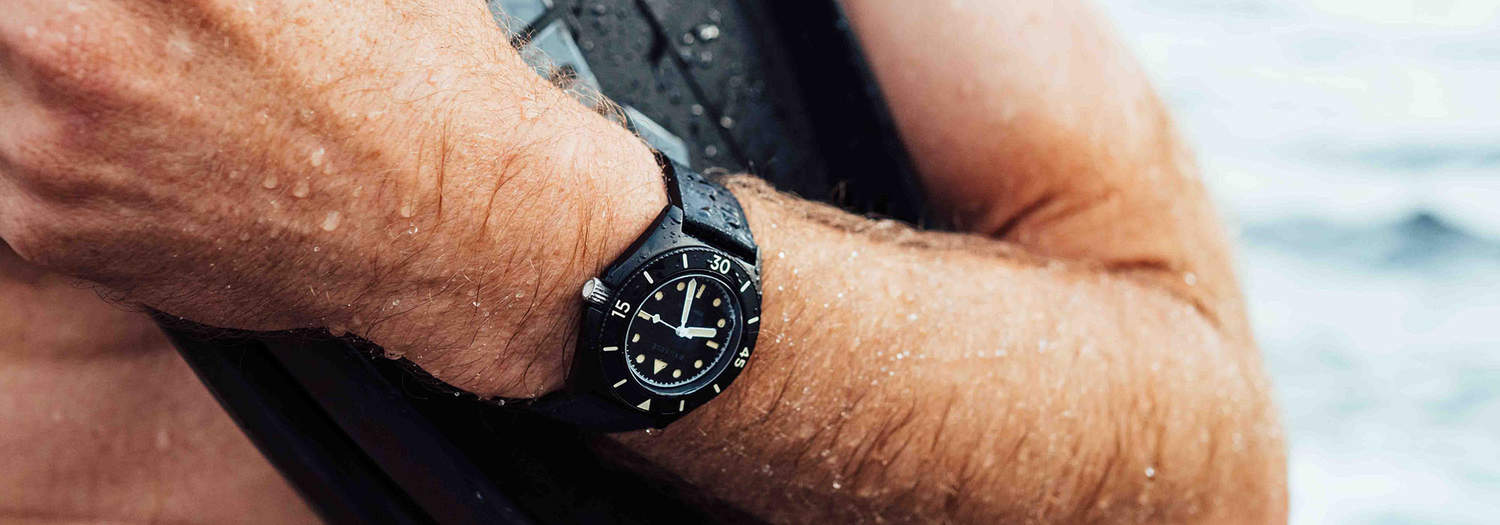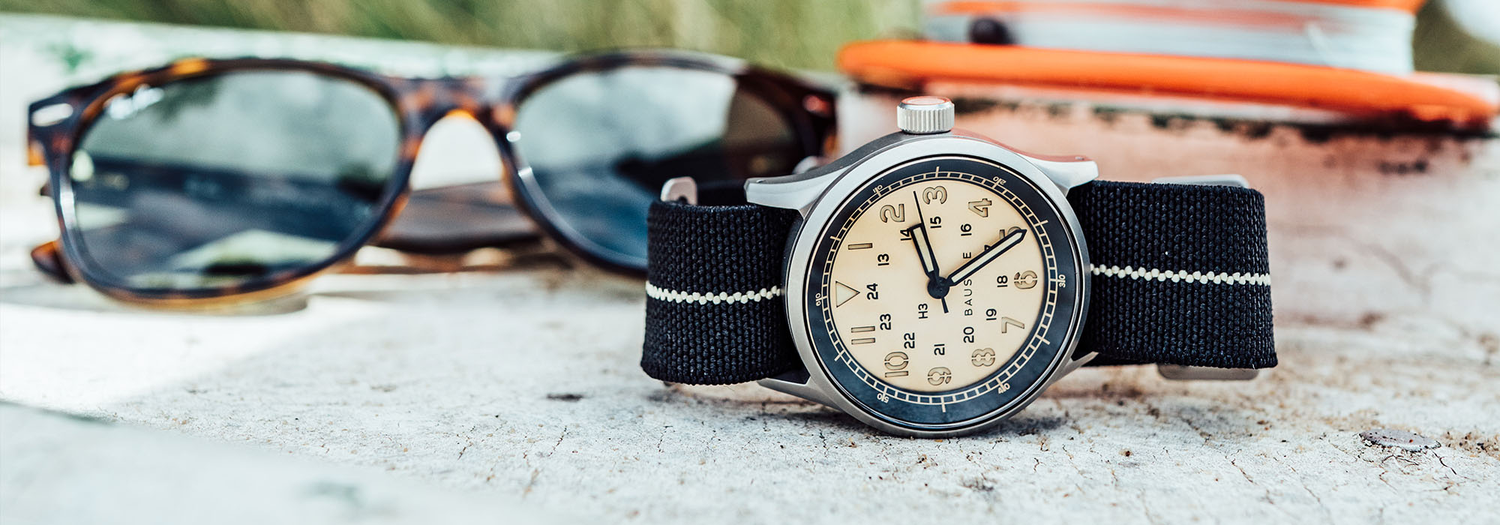The 2nd Generation of Royal Australian Air Force Watches
Bausele is releasing a very special second generation Airfield RAAF watch, now with a piece of a RAAF aircraft- either the Hercules plane at the end of August and a second iteration of the F/A-18A Hornet, at the end of September aptly named Aviator Mark II. Both watches will come in blue and black colourways. The Airfield Hercules comes with a piece of the Hercules plane in a keychain, whereas the Aviator Mark II comes with a piece of the F/A-18A Hornet in an accompanying keychain (For the Aviator only the first 200 customers will receive the keychain). These timepieces are an heirloom to remember the sacrifice of those who served whilst also a keepsake to take forth into the future and to celebrate RAAF aviation history. By purchasing this product, you are supporting historic aircraft restorations by RAAF Museum and Heritage Centres.
“From the frail wood, wire and fabric flying machines of World War I to the sophisticated multi-million dollar aircraft of today, the development of military aviation has been driven by the pace of technological development.
Through periods of war and peace, advances in airframe design and materials, aerodynamics, engines, electronics and weapon systems have transformed aircraft from an interesting curiosity to a vital component of national security and power.
The aircraft of the Royal Australian Air Force demonstrate the evolution of modern military aviation. Technologies such as the advent of the jet engine and the development of radar have flowed on to benefit civil aviation, and shaped the modern world.
Since 1921, the Air Force has appreciated the need to remain at the forefront of technological development. Today's modern equipment and systems continue that rich legacy.” - Royal Australian Air Force
A97-012 Hercules
For over 6 decades the Hercules had been the RAAF’s workhorse transport aircraft, with 48 operating over the years with 4 versions. When it was first flown in August 1954, the Hercules represented a substantial step for the United States Air Force’s Tactical Air Command when it commenced service in late 1956. For Australia and the RAAF it was an air transport capability revolution. The RAAF has operated the Hercules aircraft for 63 of its 100 years.
The Hercules has proven to be one of the great aircraft designs of the post-war era, adaptable to a multitude of roles and built in numerous variants and invariants. In continuous production since first flown, over 2500 have been built so far and the air arms of 67 nations currently operate the world’s most widely-used military transport and aircraft.
“During the last 63 years the Hercules transport fleet of aircraft participated in war-like operations in Vietnam, Timor Leste, Bougainville, Rwanda, Iraq and Afghanistan plus humanitarian assistance in Papua New Guinea, Vanuatu, Fiji, Solomon Islands, Cambodia, Philippines, Indonesia, India and the Middle East. Anyone who has been fortunate enough to have crewed the Hercules aircraft during their ADF career, irrespective of the model flown, developed an affinity that remains the highlight of their military career.” - Col Coyne President of N.37 Squadron (RAAF) Association C-130E Loadmaster 1981-1990.
A97-012 was provided to 36 Squadron in October 1978 and transferred to 37 Squadron in November 2006 and decommissioned at the end of 2012.
F/A-18A Hornet
Appointed as a fighter and attack aircraft, the F/A-18 Hornet joined the Air Force fleet in 1985 as a substitution for the delta-winged, single-engine Mirage, which had operated since 1964. The dual-engine Hornets were a major technological leap in capacity, presenting enhanced radar, navigation and artillery systems. Hornets have seen active service through implementation in the Middle East since 2001, as of late from 2014 to 2018.
The sizable and considerably updated F/A-18F series ’Super Hornets’ took over the F-111 in 2010, and will resume operation for the next decade. Now, after 36 years’ service, the A and B series ’Classic’ Hornets are being retired in 2021 with the introduction of the F-35 Joint Strike Fighter.
F/A-18 Hornets bodies and engines were mostly assembled in Australia, the local aircraft manufacturing industry being active since 1939 when the first Wirraway was produced. Australian-made or assembled RAAF aircraft include the Boomerang, Beaufighter, Mustang, Lincoln, Sabre, Canberra, Macchi and Mirage. All the F/A-18 A-model single seaters, and most of the B-model dual-seaters were produced in Australia by the Government Aircraft Factories at Avalon Victoria. The FA-18A/B models were allocated the RAAF Serial (aircraft type) number A21.
Aircraft number A21-1, the first of 57 A-model Hornets, was accepted by RAAF on 25 November 1985, and was one of 7 assigned to No. 2 Operational Conversion Unit (2OCU) at RAAF Base Williamtown, North of Newcastle, NSW. 2OCU's Hornets were marked with a yellow and black tail flash, to which the unit's tiger head insignia was later added.
Between 2015 and 2017, as part of Operation Okra, the Air Force deployed seven F/A-18A aircraft to the Middle East region on active service. Both the Squadrons and the individual aircraft were rotated, with A21-1 deployed from September 2016 to May 2017. Flown during Op Okra by 25 different pilots across all three Hornet squadrons (3 SQN, 75 SQN and 77 SQN), A21-1 clocked up 831 flying hours, the most of any Classic Hornet in a single Okra rotation.
After over 34 years, and with 6,200 flying hours – the highest number of in the fleet – the first F/A-18A to fly in Australia, A21-1, was retired from RAAF service in July 2020.
If you would like to have your own piece of aviation history to celebrate the RAAF Centenary or RAAF 100th Anniversary secure yours today. There will be no third generation of Bausele RAAF timepieces:
Bausele RAAF Airfield Hercules: https://www.bausele.com/products/royal-australian-air-force-centenary-2021-airfield-hercules
Bausele RAAF Aviator F/A-18A Hornet: https://www.bausele.com/collections/shop-all/products/royal-australian-air-force-centenary-2021-aviator-mark-ii





